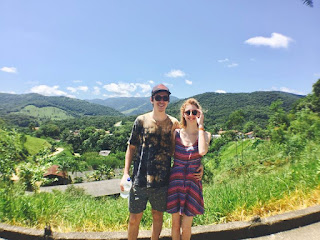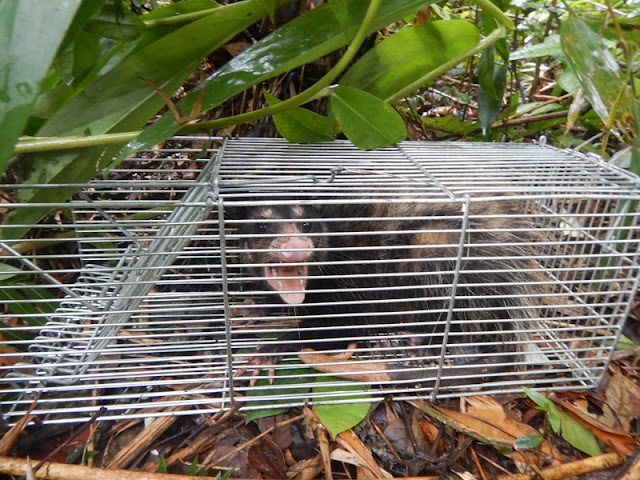My First Few Weeks at IPBio

My name is Matthew Dunlop and I came to IPBio as an assistant volunteer coordinator. My girlfriend, Morgane Holley, also came with me and she volunteered in the photography/movie-producing. This is us:
Our first few weeks in Iporanga have been action packed to say the least. Each passing day is remarkable in the sense that no particular day is quite like the last.
The work itself is both fun and rewarding. Morgane spends the bulk of her week filming and editing the other volunteers as they fulfill various tasks related to their roles. All of which is being compiled into a series of promotional videos. Check out Morgane´s volunteer video:
For more videos look though our playlists: https://www.youtube.com/user/obbioadm/playlists
 My work operates on a slightly different schedule. Monday and Tuesday
are spent in the office helping Imran, the volunteer coordinator, with his projects. Whether it’s
updating the volunteer package to “just make it look sexy dawg”, helping
to advertise the reserve online, or simply just teaching him how to use
a computer, there is always something to work on. Wednesday through Friday is where
the fun really starts. On these days we accompany a small group of
volunteers into the forest for a 10km hike… Our goal: find frogs! Now I
must elaborate here, because although collecting frogs may seem
entirely random, it’s important to remember IPBio does some incredible work and frogs are essential to their process.
My work operates on a slightly different schedule. Monday and Tuesday
are spent in the office helping Imran, the volunteer coordinator, with his projects. Whether it’s
updating the volunteer package to “just make it look sexy dawg”, helping
to advertise the reserve online, or simply just teaching him how to use
a computer, there is always something to work on. Wednesday through Friday is where
the fun really starts. On these days we accompany a small group of
volunteers into the forest for a 10km hike… Our goal: find frogs! Now I
must elaborate here, because although collecting frogs may seem
entirely random, it’s important to remember IPBio does some incredible work and frogs are essential to their process.The reserve itself is on a 60-hectare plot of land adjacent to PETAR – a state park, and the largest, most well preserved region of the Atlantic forest. The Atlantic forest, unlike the Amazon, has been almost entirely logged and we are fortunate enough to be within the small region of primary forest that remains. The Brazilian government has laws in place to protect land surrounding state parks and does not allow any land within a 10km radius to be bought for the purpose of heavy industry or agriculture. As a result, what often happens is these surrounding zones are bought and turned into privately run reserves thus ensuring the law is upheld, hence how IPBio came to be. These reserve plots act as a kind of buffer protecting the state park from surrounding anthropized land. Studying and cataloging species within the reserve and others like it is of particular importance because we are able to get a much better idea of just how much human activity is affecting the wildlife. This is where the frogs come in. For being amphibians frogs are much more susceptible to environmental changes as they breathe through their skin and live on both land and in water. They are referred to as indicator species precisely for this reason. So to summarize and to change direction – at the risk of this post becoming an all out science lesson – the reserve catalogs frog species and populations to get a better idea of how the ecosystem as a whole is doing. Additionally, we do collect frogs when it is potentially a new species, which is more common than you may think as the Atlantic Forest is brimming with all kinds of life never previously identified. For example, just last week a new species of snake, the Cropan’s Boa, was rediscovered after only once being previously described in 1953!
 Now hunting frogs would normally be no easy task because finding them in the middle of the rainforest, let alone anywhere, is pretty difficult. To compensate we setup traps called pitfalls. The pitfalls are basically large buckets dug into the ground that animals fall into and cannot escape from. The reserve only opens the buckets Wednesday through Friday to ensure no animals are stuck for too long and we check them each day they are open. They are all placed in different regions of the reserve to get a better idea of which species occupy different areas; hence the 10km hike.
Now hunting frogs would normally be no easy task because finding them in the middle of the rainforest, let alone anywhere, is pretty difficult. To compensate we setup traps called pitfalls. The pitfalls are basically large buckets dug into the ground that animals fall into and cannot escape from. The reserve only opens the buckets Wednesday through Friday to ensure no animals are stuck for too long and we check them each day they are open. They are all placed in different regions of the reserve to get a better idea of which species occupy different areas; hence the 10km hike.Another focus of IPBio is research on bioluminescent mushrooms; those that through chemical processes create their own light and effectively glow in the dark. The research they are doing in this field is particularly illuminating, and has lead to many bright ideas in terms of real world implications. I’d love to shed more light on the subject, but in actuality the only real implications it has for us, the volunteers, is that midweek we embark on a night hike into the jungle in search of flashy fungi. I wish we could have captured some photos to really highlight how spectacular this hike is. At times, entire patches of forest floor glow an eerie green and the experience is really quite otherworldly. Unfortunately, as we are working in more or less total darkness in order to view the mushrooms, it really is difficult to document. If you’re interested in finding out just how incredible these mushrooms are check out the fungi section of IPBio’s website, here.
When the workweek ends the real fun begins. Each weekend we embark on some kind of awesome activity, but by far the most common is Boia Cross. This may sound intense, or maybe it doesn’t, I’m not really even sure myself, and actually even in practice I don’t know how you would classify this activity – I suppose you could call it a conditionally extreme sport? Basically it’s a form of glorified tubing wherein each person has their own olive shaped tube that you must use to navigate down a series of rivers ranging in difficulty and speed. Some sections are incredibly intense, with rapids, boulders, and large drop-offs. While others, and these are a favourite of Imran and I, are slow enough that you can comfortably sit with a case of beer in tow until you reach your destination.
 Another common weekend activity is to explore caves. The region we are in is actually referred to as the cave capital of Brazil and for good reason. There are thousands of caves throughout the region all of which range in size and scale, and many have become popular tourist destinations. Currently, we have only explored one cave network within the state park called Nucleo Santana. Although it was exhausting the experience left us wanting more, and we will definitely be back. Each cave we visited within the Nucleo Santana network offered a unique experience. Some had us climbing large stalagmite up-growths, others crawling through very tight spaces (definitely not for the claustrophobic), and our personal favourite had us swimming from one chamber to the next in icy cold cave rivers.
Another common weekend activity is to explore caves. The region we are in is actually referred to as the cave capital of Brazil and for good reason. There are thousands of caves throughout the region all of which range in size and scale, and many have become popular tourist destinations. Currently, we have only explored one cave network within the state park called Nucleo Santana. Although it was exhausting the experience left us wanting more, and we will definitely be back. Each cave we visited within the Nucleo Santana network offered a unique experience. Some had us climbing large stalagmite up-growths, others crawling through very tight spaces (definitely not for the claustrophobic), and our personal favourite had us swimming from one chamber to the next in icy cold cave rivers. After the activities are done we usually like to spend a day in town just hanging out engaging with the locals. We played table tennis at the high school, went to a charity pizza night at the old folks home, had a night of decent Japanese food thanks to a traveling sushi chef, got haircuts, explored nearby waterfalls, and we (Morgane) always frequent the local fast food joint McDony’s – no relation – to feast on coxinhas (deep fried chicken pastries). We even went to the town’s only “club” last weekend, which only opens from midnight to 5am and is a great place if you’re in the mood for cheap drinks, crooked pool tables, crazy dancing, and hardcore Brazilian rap.
After the activities are done we usually like to spend a day in town just hanging out engaging with the locals. We played table tennis at the high school, went to a charity pizza night at the old folks home, had a night of decent Japanese food thanks to a traveling sushi chef, got haircuts, explored nearby waterfalls, and we (Morgane) always frequent the local fast food joint McDony’s – no relation – to feast on coxinhas (deep fried chicken pastries). We even went to the town’s only “club” last weekend, which only opens from midnight to 5am and is a great place if you’re in the mood for cheap drinks, crooked pool tables, crazy dancing, and hardcore Brazilian rap.This coming weekend we are celebrating Imran’s birthday and the following we plan on visiting a nearby beach town called Cananéia. Lots more fun stuff to come so stayed tuned!
Written by: Matthew Dunlop, Volunteer from Canada





Comments
Post a Comment